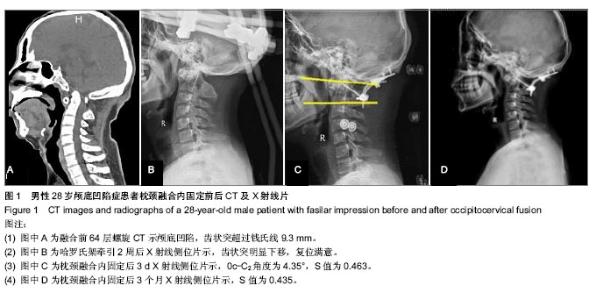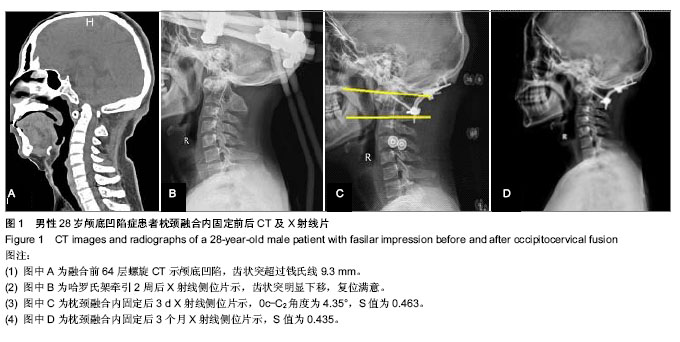| [1] Hedequist D, Bekelis K, Emans J, et al. Single stage reduction and stabilization of basilar invagination after failed prior fution surgery in children with Down’s svndrome.Spine (Phila Pa 1976). 2010;35(4):128-133.[2] 饶书成.脊柱外科手术学[M]. 2版.北京:人民卫生出版社, 1999: 270-273.[3] Moorthy RK,Rajshekhar V. Changes in cervical spine curvature in pediatric patients following oecipitocervical fusion.Childs Nerv Syst.2009;25(8):961-967.[4] Ota M,Neo M,Aoyama T, et al. Impact of the O-C2 Angle on the Oropharyngea Space in Normal Patients. Spine. 2011; 36(11): E720-726.[5] Ghosh PS,Taute CT,Ghosh D.Teaching Neumlmages: platybasia and basilar invagination in osteogenesis imperfecta. Neurology. 2011;77:e108.[6] Wang S,Wang C.Syringomyelia with irreducible atlantoaxial dislocation,basilar invagination and Chiari I malformation.Eur Spine J. 2010;19:361-366.[7] Marino DJ,Loughin CA,Dewey CW,et al. Morphometrie features of the craniocervical junction region in dogs with suspected Chiari-like malformation determined by combined use of magnetic resonance imaging and computed tomography.Am J Vet Res. 2012;73:105-111.[8] 汤四昌,刘胜刚,盛伟斌.颅底凹陷症的研究进展[J].中华临床医师杂志:电子版,2011,5(4):1072-1074.[9] 郭亮兵,廖文胜,王利民,等.Cobra枕颈内固定系统结合Halo-vest治疗颅颈交界区畸形效果[J].中国组织工程研究与临床康复, 2011,15(9):1594-1598.[10] Simsek S,Yigitkanli K,Belen D,et al. Halo traction in basilar invagination:technical case report. Surg Neurol. 2006;66(3): 311-314.[11] Arvin B,Foumier-Gosselin MP,Fehlings MG. Os odontoideum: etiology and surgical management.Neurosurgery. 2010; 66 (3Suppl):22-31.[12] 张宏其,胡希恒,刘金洋,等.对颅骨牵引结合后路枕颈融合术治疗枕颈部畸形所致寰枢椎脱位的疗效评价[J].中国脊柱脊髓杂志, 2012,5(6):500-504.[13] 余新光,尹一恒.复杂颅颈交界区畸形个体化治疗值得考虑的问题[J].中国现代神经疾病杂志, 2012,12(4):379-381.[14] 王建华,尹庆水,夏虹,等.颅底凹陷症的分型及其意义[J].中国脊柱脊髓杂志,2011,21(4):290-294.[15] Deutsch H, Regis W, Haid Jr, et al. Occipitocervical Fixation: Long-Term Results. Spine. 2005;30(5):530–535. [16] 倪斌, 肖建如,陈德玉,等.枕颈融合Cervifix内固定术[J].中国脊柱脊髓杂志,2003,13(10):227-229.[17] 陈赞,孙永华,吴浩,等.前屈、后伸位MRI对判断颅脊交界区畸形内固定指征的临床价值[J].中国现代神经疾病杂志, 2011, 11(4): 444-448.[18] 尹庆水,艾福志,章凯,等.经口咽前路寰枢椎复位钢板系统的研制与初步临床应用[J].中华外科杂志, 2004,42(6):325-329.[19] Wang C, Yan M, Zhou HT, et al. Open reduction of irreducible atlantoaxial dislocation by transoral anterior atlantoaxial releaseand posterior internal fixation. Spine (Phila Pa 1976). 2006;31:E306-313.[20] Ugur HC,Kahilogullari G,Attar A,et al. Neuronavigation-assisted transoral-transpharyngeal approach for basilar invagination-two case reports.Neund Med Chir(Tokyo). 2006;46(6):306-308.[21] Wang C,Yan M, Zhou HT,et al. Open reduction of irreducible atlantoaxial dislocation by transoral anterior atlantoaxial release and posterior internal fixation.Spine. 2006;31(11): E306-313.[22] 王玉强,王利民,张玮,等.利用手术显微镜教学观察镜接口组装视频输出系统及其临床应用[J].中国修复重建外科杂志,2011, 25(3): 331-334.[23] Goel A. Treatment of basilar invagination by atlantoaxial joint distraction and direct lateral mass fixation. J Neurosurg Spine. 2004; 1:281-286.[24] Jian FZ, Chen Z, Wrede KH, et al. Direct posterior reduction and fixation for the treatment of basilar invagination with atlantoaxial dislocation. Neurosurgery. 2010;66:678-687.[25] Menezes AH. Craniovertebral junction abnormalities with hindbrain herniation and syringomyelia:regression of syringomyelia after removal of ventral craniovertebral junction compression. J Neurosurg. 2012;116:301-309.[26] 沈奕,李晓淼,王伟力,等.骨形态发生蛋白7在骨科的应用[J].中国组织工程研究与临床康复,2011,15(26):4864-4867.[27] Uchino A, Saito N, Watadani T, et al. Vertebral artery variations at the C1-2 level diagnosed by magnetic resonance angiography. Neuroradiology. 2012;54(1):19-23.[28] 王建华,尹庆水,夏虹,等.数字骨科技术在寰枢椎个体化置钉手术中的应用[J].脊柱外科杂志,201l,9(3):165-168.[29] 艾福志,尹庆水,夏虹,等.数字骨科技术在颅颈交界疾患外科治疗中的临床应用[J].脊柱外科杂志,2011,9(3):169-174.[30] 邱勇,刘臻,王斌,等.脊柱前路手术髂前嵴取骨并发症相关分析[J].中国脊柱脊髓杂志,2007,17(8):584-587.[31] Matsunaga S, Onishi T, Sakou T.Significance of Occipitoaxial Angle in Subaxial Lesion After Occipitocervical Fusion. Spine. 2001;26(2):161-165.[32] Ojiri K,Matsumoto M,Chiba K,et al.Relationship between alignment of upper and lower cervical spine in asymptomatie individuals. J Neurosurg. 2003;99(1):80-83.[33] Miyazaki M,Hymanson HJ,Morshita Y, et al.Kinematic analysis of the relationship between sagittal alignment and disc degeneration in the cervical spine.Spine. 2008;33(23): 870-876.[34] 王圣林,王超,Wood KB,等.寰枢关节不稳或脱位患者上颈椎曲度改变对下颈椎的影响[J].中国脊柱脊髓杂志,2009,19(7): 502-505.[35] Kotani Y, Takahata M, Abumi K, et al. Cervical myelopathy resulting from combined ossification of the ligamentum flavum and posterior longitudinal ligament: report of two cases and literature review. Spine. 2013;13(1):e1-6. [36] Woiciechowsky C,Thomale UW,Kroppenstedt SN. Degenerative spondylolisthesis of the cervical spine: Symptoms and surgical strategies depending on disease progress. Eur Spine J. 2004;13(8):680-684.[37] Koakutsu T,Nakajo J,Morozumi N,et al. Cervical myelopathy due to degenerative spondylolisthesis. Ups J Med Sci. 2011; 116(2):129-132.[38] Jiang SD,Jiang LS,Dai LY. Degenerative cervical spondylolisthesis: A systematic review. Int Orthop. 2011;35(6): 869-875.[39] 方加虎,贾连顺,周许辉,等.颈椎僵硬型后凸畸形的临床评估和手术入路选择[J].中国矫形外科杂志,2010,18(13):1057-1060.[40] Kwok AW, Wang YX, Griffith JF,et al. Morphological Changes of Lumbar Vertebral Bodies and Intervertebral Discs Associated With Decrease in Bone Mineral Density of the Spine:a cross-sectional study in elderly subjects. Spine. 2012; 37(23):E1415-1421. |



